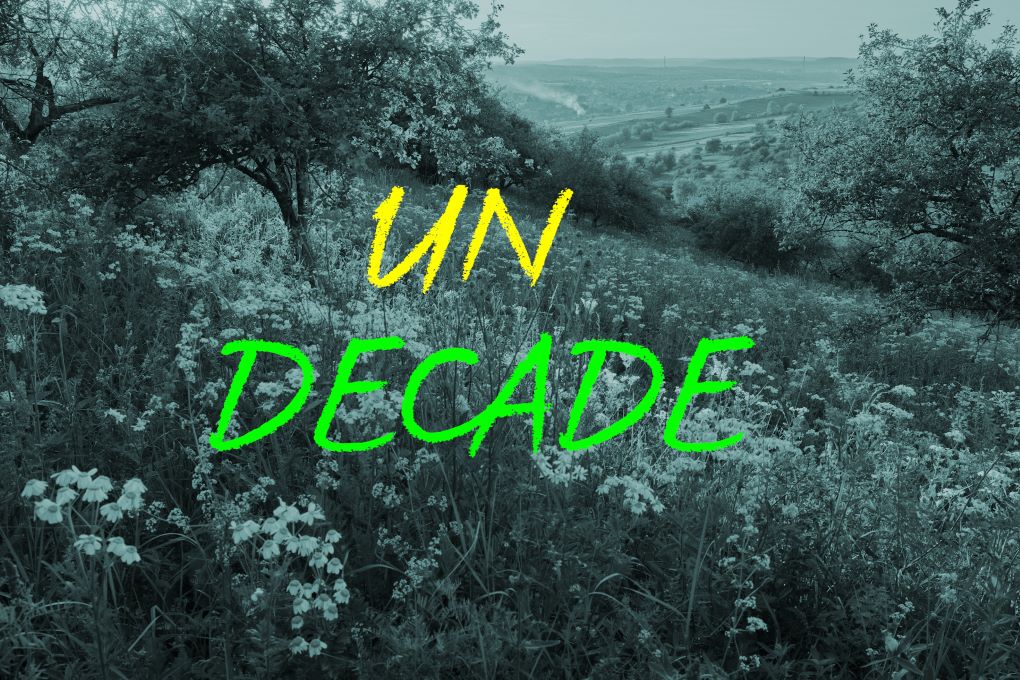Corporate sustainability goes hand in hand with many terms and…

Water is life – These techniques work to protect the climate
Water is the element of the 21st century: How can we prevent the gentle wet from becoming aggressive – too much as floods, too little as droughts? Principles and techniques from successful projects show solutions that can be applied here and now.
AGUA NA TERRA - TRAILER
Tina Teucher attended a course on „Water Retention Landscapes“ in July 2022 in the eco-village of Tamera in Portugal – in one of the driest regions of Europe. Key findings from the experience are shown in the following overview.

Water is life:
- Humans are made up of 70% H2O.
- Plants and animals live from water.
- The water cycle shapes the world’s climate.
- The disturbed water cycle changes the world climate in a way that threatens human civilization.
- Thus, re-balancing the water cycle is active climate protection.
Instead of getting angry about water, we can harvest it and use it for ourselves. Natural and decentralized water management enables reforestation, healthy soils and agriculture – even in regions threatened by desertification.
The water cycle as it should be
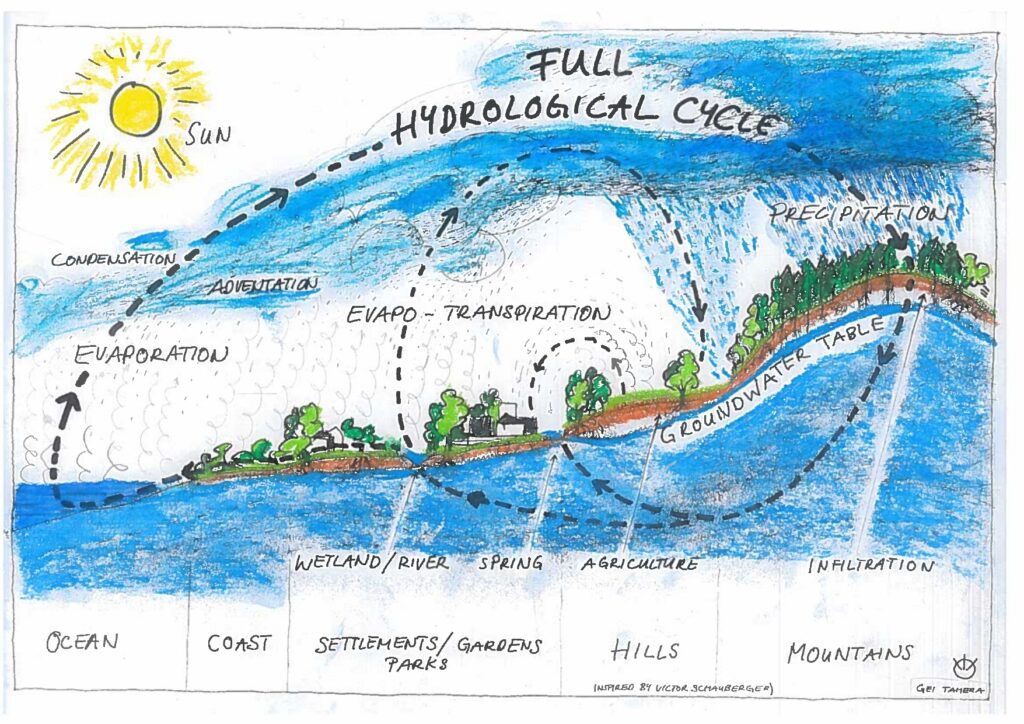
Water naturally follows healthy cycles:
- Water is drawn into the air by the power of the sun from the sea, rivers and lakes and condenses on tiny particles to form clouds (evaporation, condensation).
- Plants store a lot of water in their leaves, roots and soil. Even dead plant parts store moisture: 1 square meter of topsoil containing organic debris from trees stores 5 liters of water.
- Trees “sweat” out water through their leaves, which also forms clouds (evapotranspiration).
- The clouds rain water over the land, which is reabsorbed by the soil as well as plant roots and seeps into deeper layers as groundwater. Partly it comes back to the land surface as springs.
- Some of the water flows through streams and rivers into the sea.
The disrupted water cycle as it mostly looks like today
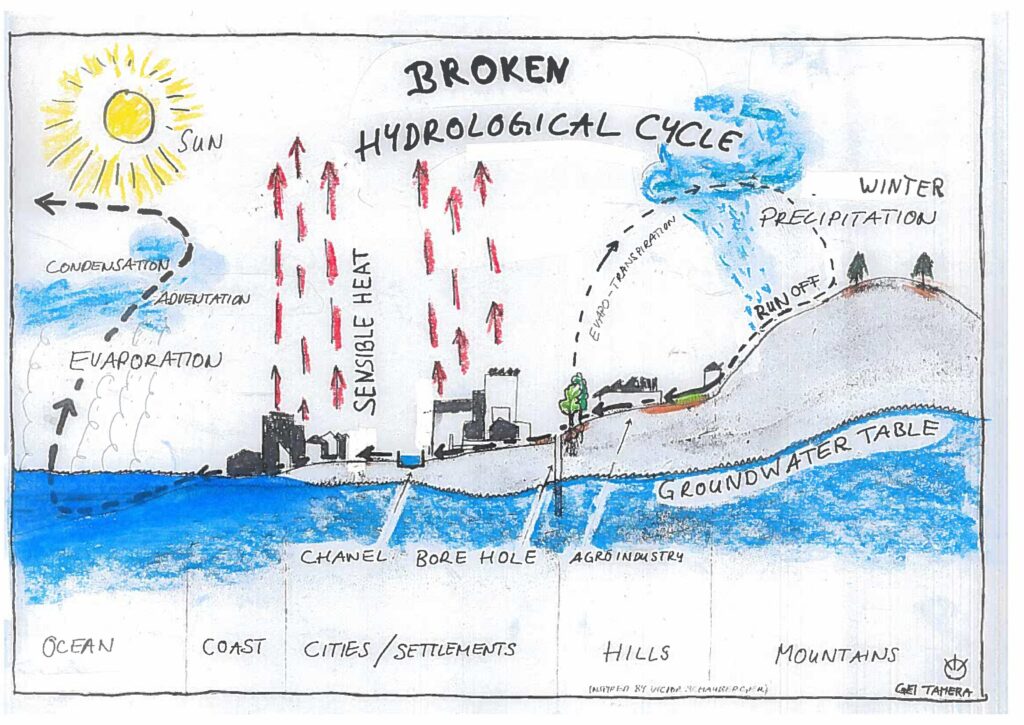
There are several disturbing factors in the disrupted water cycle:
- Cities, settlements and large buildings on the coast form heat islands. They prevent clouds from moving inland. Hardly any rain comes on land. The clouds that do break through the “wall of concrete” are very large and can lead to rainfall that floods the land.
- Deforestation of trees results in less root mass – the soil becomes less able to absorb and store water. Water runs off mountains, hills and slopes unimpeded, greatly accelerated.
- Deforestation of trees also results in fewer plants releasing water, resulting in fewer clouds forming.
- Canals straighten and narrow rivers. This further accelerates the flow of water and encourages flooding. Large check dams also interrupt the natural flow of water.
- Agroindustry uses the little water that is left for artificial watering and poisons the groundwater with pesticides (plant toxins).
- Groundwater table drops because less water reaches or is stored on the land as rain. Springs dry up.
- To ensure that people can still access water for their supplies and industry, they drill deeper and deeper bore holes in the ground, which causes the groundwater level to drop even further.
- In extreme cases, the sea level near the coast rises above the groundwater level – the drinking water for entire cities becomes saline and has to be treated at great expense.
- The broken water cycle changes the regional and global climate. One example: droughts cause forest fires, which release CO2 from trees into the atmosphere. This leads to climate heating. Therefore, the following applies: near-natural water management is active climate protection.
“Mankind has the knowledge of how to transform deserts and semi-deserts back into living landscapes with flowing watercourses. In most cases, desertification is not a natural process, but the result of incorrect water management worldwide. Deserts are not created by lack of rain, but because humanity mishandles water.”
Tamera
Key Water Management Learnings:
- „Water is the missing link for reversing climate change.
- It’s possible to achieve water autonomy in our region and everywhere in the world.
- When restoring the natural water cycles, we take the first, indispensable step for restoring ecosystems and lay the foundations for self-sufficiency.
- Wherever you are, make sure rainwater doesn’t run off, but instead filters into the aquifers.“ (Source: Tamera)
Principles for water retention: how can we manage water on any land?
If possible, a water retention landscape does not allow rainwater to run off the property, but instead holds it – the soil absorbs the water. It cleans, matures and mineralizes it. Then it can resurface as a spring, or plants released it into the air.
Anyone who owns or shares responsibility for land such as fields, gardens or properties can help repair and heal the water cycle. Opportunities include:
- Provide vegetation and root mass to improve the soil’s ability to absorb water. So, for example, plant ground covers and trees
- Unseal where possible. For example, plant vegetation on unnecessary parking lots and driveways, and on flat roofs
- Follow principles for water retention
Those who have land can apply the following principles for water retention:
1. observe
2. start at the top
3. start small
4. slow, spread, sink
5. plan overflow
6. create living sponge
7. stack functions
8. feedback loops
9. from pattern to detail
1) Observe
Spend at least one year observing the land to experience all seasons, learning and recognizing local conditions:
- Climate
- Landscape
- Vegetation
- Soil
Questions to ask yourself for this purpose include:
- What is my average annual rainfall (in mm)? So how many liters of water could I potentially “capture” on my area (with x m2)?
- For example, if you live in Brandenburg (Germany), with an average rainfall of 500mm/year (equivalent to 500 liters per square meter per year) and you have an area of 1 hectare (10,000 square meters), your land theoretically has 5,000,000 (5 million) liters of water available. Quite a lot! If only it could be used. More on this below.
- What public data is available on climate, soil, etc.?
- What other water sources (e.g., streams) exist on my land?
- Where does my water come from? Where does it go?
- What is the slope on my land?
- Where is my land located within the watershed (at the source, next to the oxbow of a river, in the estuary…)?
- What plants grow naturally here and what are their needs in terms of water?
- What culture is common on the land? What techniques (ancient or modern) were used? (e.g. terraces that can protect against erosion).
- What do neighbours, parents, grandparents know about traditions and stories related to the land and its water? (e.g., names of towns and bridges often go back to the water situation)
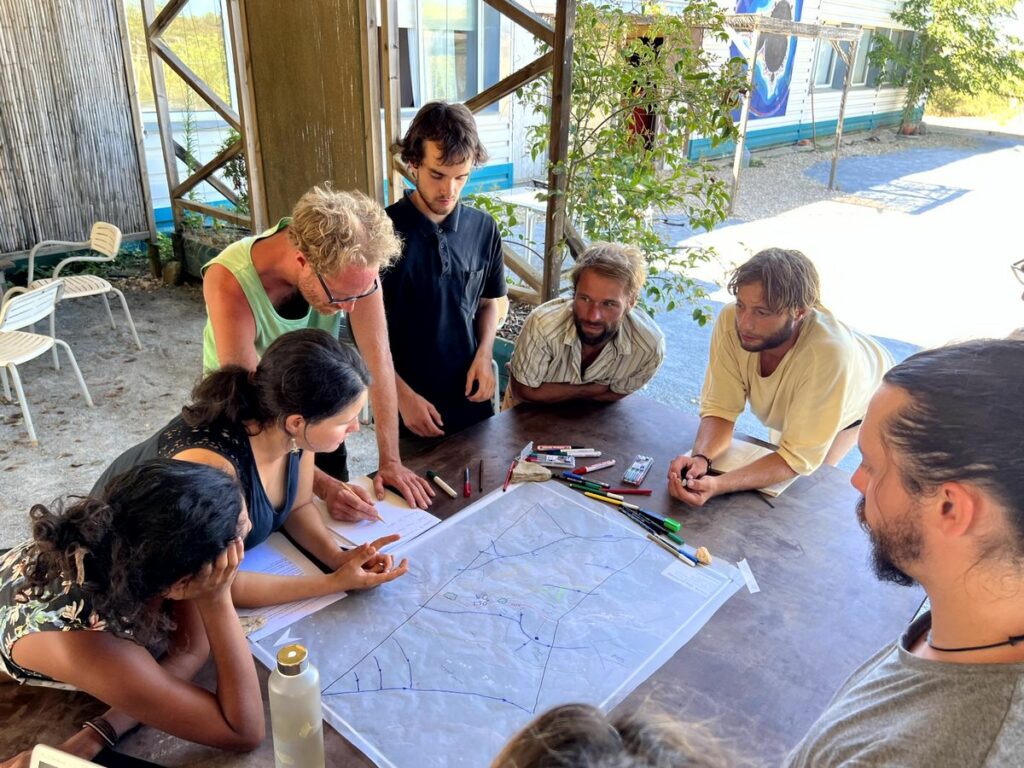
2) Start at the top
Measures to improve water retention should start at the top of the watershed (on the “hill” or slope). From there, you can “work your way down”.
3) Start small and simple
Creating a huge lake right away is not the point! Instead, even small earthworks can be very effective. Carrying them out, observing their effects and adjusting if necessary is the key to success.
4) Slow, spread and sink
To prevent water from running away from us unused (drought) or flooding certain places (floods), we can “slow it down.” The goal here is to slow its course, spread it out as much as possible, and let it seep into the ground to raise the water table. There are several techniques for doing this, which are explained below.

5) Plan overflow.
Water finds its way. If a basin or watershed is “full,” it overflows. But you can control where this happens – by preparing ahead for floods and planning an overflow. The flow of water can be directed in the desired direction – for example, to other basins where plants gratefully absorb the moisture.
6) Create a living sponge
In a healthy biotope, the soil functions like a sponge: its top layer of humus absorbs rainwater and releases it into the soil. The texture of the soil determines where the water goes. Compacted soil allows it to run off more quickly. Loosened soil, on the other hand, helps it seep in, which provides water to plant roots and replenishes groundwater tables. Where the soil is too sandy and water seeps too deeply too quickly, soil must be built up. You can do this with plants, their roots, and dead plant parts such as dead leaves, composting into humus. The goal is to help the soil become a living sponge that can absorb as much water as possible.
7) Stacking functions
Each measure can achieve more than just “harvesting” water. Especially if it is used to strengthen vegetation. For example, a water basin can be a beautiful sight, nourish a sense of abundance, be a playground for children, and a watering hole for birds and insects.
8) Feedback loops.
The land provides feedback: it responds to change. It is important to always monitor and evaluate the system. A special moment is the first rainfall after a change intervention: go out and observe what the water does! Where does it flow, which paths does it seek, where does it collect and accumulate, where does it sink into the ground?
9) From pattern to detail
If you take a step back, you will recognize patterns – in nature, but also in society. Such patterns form the backbone of a landscape design, enriched with more and more details from continuous observations.
The principles are described in detail in books such as
- Brad Lancester: Rainwater Harvesting for Drylands and Beyond.
- Bill Mollison: Permaculture design handbook.
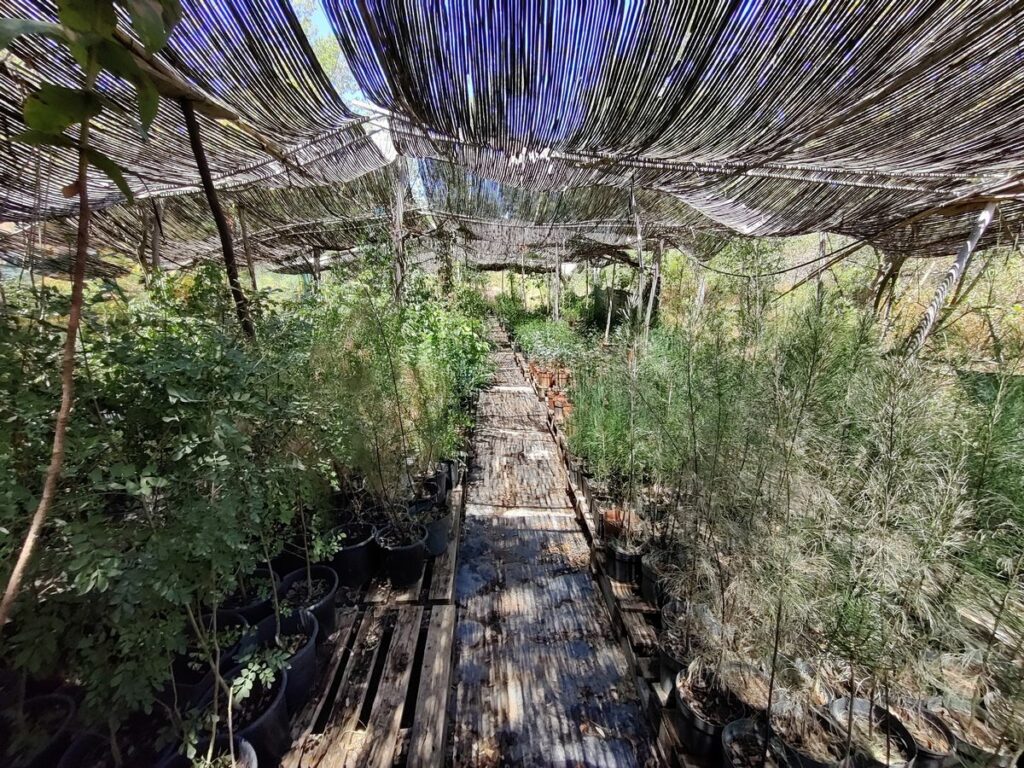
Water retention techniques: How to keep water on your land
To keep water on one’s land, there are some measures. At the same time, their application ensures that the water cycle is closed, repaired, healed.
Those who have buildings and land available should divert as much water as possible from there into storage tanks. These can be located underground or installed as rain barrels. In addition, “gray water” – i.e. wastewater from showers, sinks and washing machines – can be drained into the surrounding vegetation. The prerequisite for this is the use of biodegradable cosmetics, detergents and cleaning agents.
Water retention techniques include:
- Slopes
- Mulching and seeding
- Berms on contour
- Infiltration basins
- Swales
- Check dams
- Terraces
- Deep tilling with ripper
- Deep tilling with keyline plow
- Water retention basins
The following applies to all earthworks: Whoever moves soil should protect it directly afterwards, by mulch and vegetation! Otherwise, there is a risk of drying out due to direct sunlight or erosion by wind and water.
Slope
The steeper the slope, the smaller the structures: Earthworks should be correspondingly narrower when the slope is steeper, and the more of them you need.
This supports gentler slopes and banks on our structures allowing vegetation to root and stabilize the earthworks.
Mulching and seeding
Revegetation!
Close any earth that you opened. Cover bare soil with organic matter. For planting, choose local seeds with deep roots that can cover the soil fast. Work with local hay because it already contains native seeds.
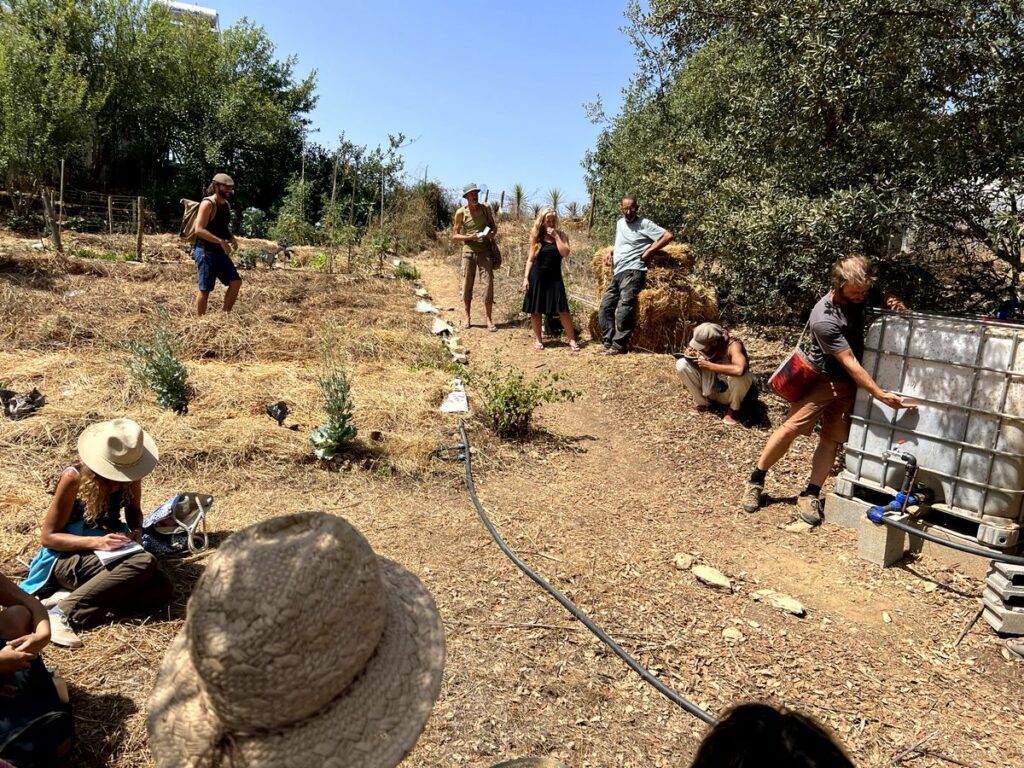
Berms on contour
A berm is a horizontal piece on a slope. Put on the same contour lines allows water running off the slope to slow down and infiltrate. To retain even more water, add organic matter to the berm and plant it on the upper side or in basins.
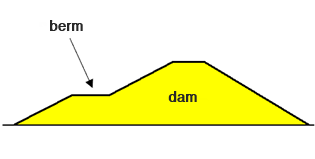
Infiltration basin
Any tree will be happy to have a small swale in which to accumulate water.
Swales
Swales are like small depressions or hollows. Such gentle ditches along contour lines on a slope form little waves in the landscape, like little snakes. They can be dug by hand, shovel, digger, tractor, or plow. As a green belt, they create their own microclimate in their surroundings – a good opportunity to plant trees.

Check dams
The goal of a dam is to slow the water in a ditch, stream, or river, raise the ditch, and stop erosion. This is because fast-flowing water carries away a lot of material, especially in straightened channels. A check dam can be made of a wide variety of materials, depending on what is available on site: rocks, logs or stakes, bales of straw, or brushwood from shrubs.

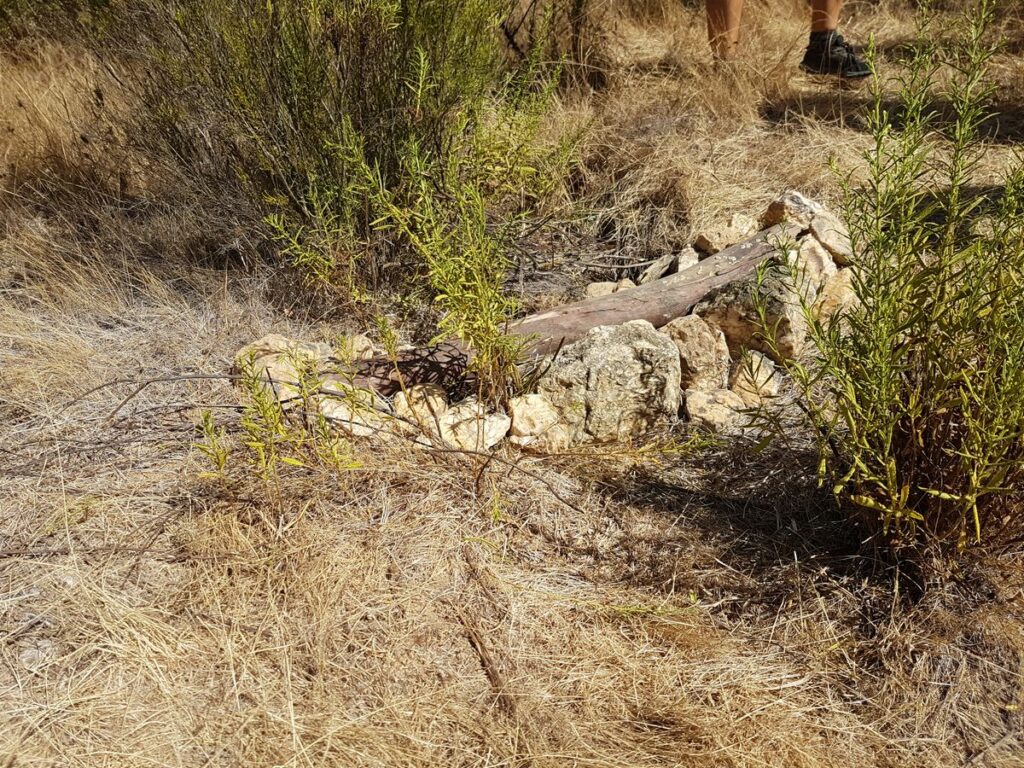
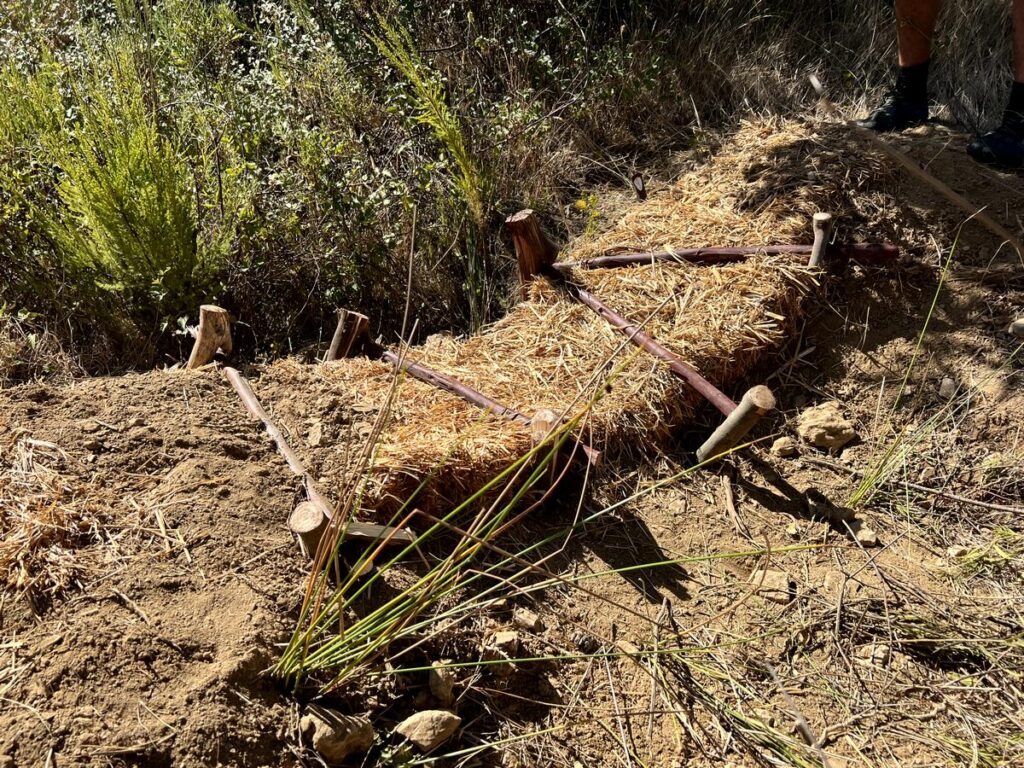
The effect: sediments washed up fill the dam, the creek is lifted up, the water is slowed down. It is also important here – as with all earthworks – to plan an overflow.
Terraces
A terrace is a horizontally level piece on a slope, similar to a berm but usually wider. Terrace construction is relatively energy intensive – it requires bulldozers or excavators. The terrace may lay downslope or toward the hill, the latter acting as a small depression in the hill in which to sow seeds. On rocky ground, terrace construction is often not worth it. It is important to also fill the newly created terraced area with organic material to protect it from erosion.
Deep tilling with ripper
Deep tilling with a ripper breaks up the hard soil to make planting easier. Again, it is important to measure the contour lines beforehand and then work along them.
Deep tilling with keyline plow
A subsoiler mechanically breaks up the soil in a depth of approx. 30 cm. This is particularly appropriate when the subsoil is heavily compacted, so that roots can grow poorly and water accumulates. This technique takes place away from the contour lines. The device for this is called “Keyline Plow”, a plow for the application of the Keyline design according to P.A. Yeomans.
Water retention basins
Although building ponds and lakes seems the most enticing, this measure should be taken with caution. It requires the most engineering and forms the largest intrusion into the existing landscape. Moreover, it makes sense to build them at the bottom of the slope – but one of the principles of Water Retention Landscapes is: start at the top. That’s what’s seen today in the flagship Tamera project, where beautiful lakes (officially, water retention basins) have been created, but work is now being done primarily higher up the slope.

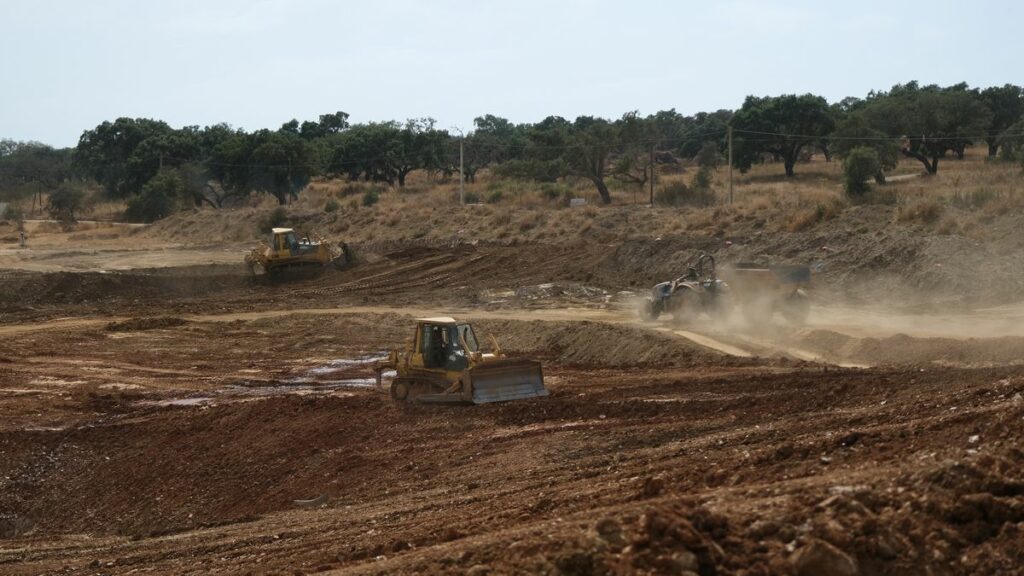
Water as a Metaphor: A Crisis of Relationships
Without the benefits of a functioning water cycle, entire ecosystems flood or dry up – and with them, people suffer. Because intact ecosystems are habitats, also for the species homo sapiens.
More and more activists worldwide are therefore campaigning for the healing and repair of water. This is by no means only about technical solutions, as shown above. One of the founders of the “Standing Rock” movement for indigenous water rights in North Dakota says: “The ecological crisis is not a technological problem, but a crisis of relationships.“
The dominant European culture sees nature as the opposite of culture. Nature is something that needs to be tamed, civilized, cleaned up. It is an attempt to find comfort in controlling others. Yet it is no coincidence that we are experiencing an unprecedented crisis of mental health and psychological stress, concurrent with the mass extinction of species and the global loss of ecological diversity. Both are accompanied by a deep sense of impoverishment and loss. “How we understand the ecological crisis will determine how we respond to it,” say the makers of the film “Water is love” in a trailer.

Water is a being: With soul, memory and wisdom
- How do we take responsibility for the land?
- How can we use our privileges to change the system?
- How can we be good ancestors?
One key may be to respect and treat the seemingly inanimate as life. A song in Portuguese reflects this attitude:
A agua é um sé
Té alma
Té memoria
Té sabé
(The water is a being. It has a soul, it has memory, it has wisdom).
Water is Love | Water Cycle Animation | Trailer
WATER is LOVE - Crowdfunding
Read more, get inspired and discover solutions:
More on water retention landscapes
https://www.tamera.org/water-retention-landscape/
Next opportunity to participate in the course
Sept. 16-19, 2022, brief introduction
https://www.tamera.org/events/introduction-to-water-retention-landscapes-september-2022/
Great Youtube channel of Silvano Rizzi, lecturer from the ecology team of Tamera
https://www.youtube.com/channel/UCx1LPKiJtTfmX1k-p4sLpPg
Campaign against a dam project in the Portuguese region Alentejo
https://www.gofundme.com/f/proteja-o-pnsacv
Cover photo: Edited by Team TNT, original photo: Tim Vögelin
Tina Teucher is a speaker and moderator with focus on sustainable business. As a sustainability expert, she brings over 12 years of experience in topics such as regenerative business, green innovation and business ethics into her work. In 2022, Tina Teucher is particularly committed to ecosystem restoration and aims to bring together international stakeholders through the Generation Restoration initiative. She is the author of the book “Biodiversity“ and reports on her visits to regenerative places on her blog.
If you would like to read articles by and about Tina Teucher on a regular basis, simply subscribe to the newsletter. It is published about 4 times a year.

